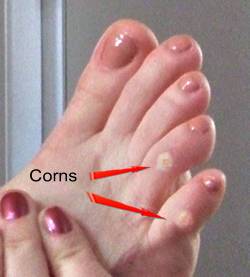Corns
/kɔɹnz/
1. [noun] corns (similar to calluses) are areas of thick skin caused by repeated pressure or friction on an area of skin. The pressure causes the skin to die and form a hard protective surface with a dense core. For feet they may cause pain when walking or wearing shoes. Corns have an inner core that can be soft or hard. Soft corns are found between the toes. Hard corns form on the tops of toes. Often corns caused by shoes will go away with the right sized shoe wear. See: https://www.healthlinkbc.ca/health-topics/ug2399 ; Accessed May 14 2019 There are three most common types of Corns Seed Corns (heloma miliare): A seed corn, as the name implies, is a small, dry and stiff seed-like bump that can develop anywhere on the foot but typically pops up on the ball or heel of the foot, or on weight bearing areas. There are two types of corns. Soft corns (heloma molles) usually occur as the result of bone abnormalities in the toes. They develop between the toes and are sometimes referred to as "kissing corns." Hard Corns (heloma durum): Hard corns (heloma durums) are the most common type. They are caused primarily by ill-fitting shoes and toe deformities. They usually develop on the tops and tips of the toes and on the sides of the feet. In many people, the toes curl downward and do not lie flat. Fitting curled toes into shoes with tight toe boxes is a common cause of hard corns. The toes remain curled inside the shoe and press against the inside of the shoe, usually at the toe joints. Additionally, the tip of the curled toe presses against the sole of the shoe. The skin compensates for this added pressure by thickening at the point of contact and hard corns develop to protect the underlying structure. Soft Corns (heloma molle): Soft corns typically develop between the fourth and fifth toes when one of the toe bones (phalanges) is slightly too wide. Normally, phalanges are hourglass-shaped and the ends are wider than the middle. Soft corns result when the ends of the toe bones are too wide, causing friction in between the toes. This problem is aggravated by tight-fitting shoes. People with normal toe bones can also develop soft corns. This condition is especially common in women who wear high-heeled shoes with narrow, tapering toe boxes. These shoes shift the body's weight to the front of the foot and often do not provide enough room for the toes. Caution with the interdigital or soft corns, there is a high risk of Osteomylitis See: http://www.healthcommunities.com/corns/overview.shtml ; Accessed May 14 2019 Seed Corns Image source: Tannis Sorge Interdigital Soft Corn, also known as "kissing corns" Image source: Tannis Sorge



Frequently Asked Questions
How can everyday activities lead to developing corns on the feet?
Repeated pressure from daily activities—such as long walks in tight-fitting shoes—can cause the skin on the feet to thicken and develop a hard core. This is an adaptive response to protect areas that experience consistent friction.
Many assume corns and calluses are the same; what distinguishes corns on the feet?
Corns typically form in specific areas like the tops of toes or between them, and they have a dense, defined core. In contrast, calluses are broader, less localized thickened skin areas on the sole or heel.